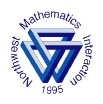Program
Local Hosts: Carol Hattan and Karen Hall
Program announcement:
Michael Freeman - A hands-on tour of Mathematical Induction
via the Towers of Hanoi Puzzle
This famous puzzle is a stack of disks of graduated size piled on
one of three posts. The object is to move them all to another of the
posts according to certain restrictive rules. It can be completely
understood only through the technique of Mathematical Induction, and
affords a vivid and engaging way to illustrate this extremely important
method of reasoning. Puzzles will be provided, and other illustrations
of inductive reasoning will be drawn from elementary geometry and
number theory.
Kris Koch - Geoboard and Areas
We will quickly review some standard ways to find area of shapes
on geoboards (adding up known shapes, subtracting from a enclosing
rectangle, Pick's theorem) but then spend time deciding if two new,
startlingly simple methods actually work, and if so, why?
Karen Hall - Circles and Cones: An Investigative Activity
This session demonstrates an investigative activity to determine
the relationship between the radius of a circle and the volume of
a cone made from that circle.
Celeste Williams - Packing Circles Old and New
The process of starting with tangent circles and then packing smaller
tangent circles into the gaps has fascinated mathematicians and designers
for centuries. We will learn about relationships that start with Descartes
and continue to present-day discoveries. This will then be connected
to student activities in geometry and even quadratic equations.
MaeLynn Anderson - The golden ratio, digital cameras and Sketchpad
Learn how she used a digital picture of each of her students (both
whole body and head shot) to explore the golden ratio by putting the
pictures into Geometer's Sketchpad.
Carol Hattan - A Probability Simulation with Fathom
We will start with a simple probability simulation and then model
the same simulation with Fathom software. There will be an opportunity
for each participant to explore the power of Fathom for data, probability
and function work.

